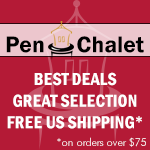I like the fact that I am seeing more and more Sailor pens of the non-fountain pen variety become available. It's possible these pens have been all over Japan for years, but I feel like it is a special treat when someone like JetPens imports them and makes them available to more people.
The Sailor Fude Nagomi Brush Pen was made in conjuction with a popular Japanese calligrapher named Ryofuka. She had a hand in the design of the pen, including the curved grip section, which I quite enjoy. In looking at the pamphlet of tips that came with the pen, it appears she prefers holding the pen at a very vertical angle. I find that interesting because I do that when writing, but for the broader strokes required with brush pens it seems odd.
It may work well with this extra fine model though, because there is very little line variation to be had. It reminds me a lot of the Kuretake Fudegokochi which I love for its general writing ability. This Sailor is very much the same, and will be primarily used for tasks that require smaller, more defined styles.
Many other, more standard, brush tips are available too, so be sure to take a look at all of the options that Sailor has brought to the table if you like the shape and style of this barrel.
(JetPens provided this product at no charge to The Pen Addict for review purposes.)



















